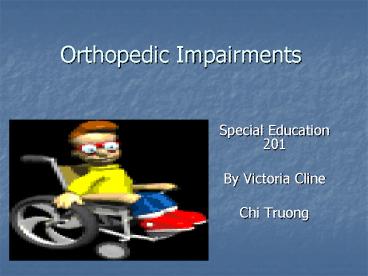Orthopedic Impairments - PowerPoint PPT Presentation
1 / 17
Title:
Orthopedic Impairments
Description:
... comparison 2006 'For every 100 girls with orthopedic impairment 118 boys have ... Video on You Tube about Disabilities. http://www.youtube.com/watch?v=4aFVTlISue8 ... – PowerPoint PPT presentation
Number of Views:2016
Avg rating:3.0/5.0
Title: Orthopedic Impairments
1
Orthopedic Impairments
- Special Education 201
- By Victoria Cline
- Chi Truong
2
Laws
- Individuals with Disabilities Act PL 108-446
- New Mexico State Law
- ADA Americans with Disabilities Act
- Section 501 of Rehabilitation Act
3
Federal LegislationIDEA Public Law 108-446
- Orthopedic Impairment means a severe orthopedic
impairment that adversely affects a childs
educational performance. The term includes
impairments caused by a congenital anomaly,
impairments caused by disease (e.g.,
poliomyelitis, bone tuberculosis), and
impairments from other causes (e.g., cerebral
palsy, amputations, and fractures or burns that
cause contractures). Sec 300.8 (c) (8)
http//idea.ed.gov/explore/view/p/2Croot2Cregs2
C3002CA2C300252E82C
4
New Mexico
- Accepts the federal definition under IDEA
- Clarifies the definition in NM TEAM April 2007
Article by stating - an orthopedic impairment involves a chronic
physical or structural limitation of the
skeleton, joints, muscles, and/or fascia. This
may cause impaired ability to use, move or
control the arms, legs, hands, feet, head, neck,
and/or trunk resulting in difficulty in the
performance of gross-motor and/or fine-motor
activities. Disabilities may be congenital or
acquired anomalies, excluding traumatic brain
injury.
NM TEAM Orthopedic Impairment Section April 2007
p. 90
5
Do Children with Orthopedic Impairments
automatically qualify for special education?
- Have a disability as defined by IDEA
- Must affect academic achievement
6
ADA and Section 504
- Except for accessibility of buildings, and
modifications and accommodations in testing,
Section 504 and ADA provide few protections and
limited benefits to children with disabilities. - This impairment must substantially limit at
least one major life activity. Major life
activities include walking, seeing, hearing,
speaking, breathing, learning, reading, writing,
performing math calculations, working, caring for
oneself, and performing manual tasks. The key is
whether the child has an "impairment" that
"substantially limits . . . one or more . . .
major life activities.
http//www.wrightslaw.com/info/sec504.summ.rights.
htm
7
Orthopedic Impairment
- Causes
8
Orthopedic Impairment - Causes
- Impairment due to congenital anomaly
- Clubfoot
- Impairment due to effects of disease
- Poliomyelitis
- Bone tuberculosis
- Impairment from other causes
- Cerebral palsy
- Amputations
- Fractures
- Burns that cause contractures
9
Poliomyelitis
- Also called Polio
- Highly contagious infectious disease caused by 3
types of poliovirus - Virus that causes destruction to nervous system
paralysis - 95 of cases produces no symptoms (asymptomatic)
- 4-8 cases produces symptoms (symptomatic)
10
Cerebral Palsy
- Group of chronic conditions that affect body
movements and muscle coordination - Caused by damage to one or more specific areas of
brain (usually during fetal development) - More people in U.S. have cerebral palsy than
other development disability.
11
Brachial Plexus/Erbs Palsy
- Brachial Plexus Injury nerve injury
- Nerve that control muscles in shoulders, arm or
hand are damaged causing muscles to be paralyzed - If arm of newborn is weak, child may have
Brachial Plexus Palsy.
12
Muscular Dystrophy
- Group of genetic diseases by weakness and
degeneration of skeletal muscles that controlled
movement - 9 types (all loss of strength, increase
disability, and deformity) - 3 most common Duchenne, facioscapulohumeral, and
myotonic
13
Spinal Cord Injury
- No cure at present
- Spinal cord begins with sudden traumatic blow
that fractures or dislocates vertebrae - Damage begins when bone fragments or disc
materials are displaced, bruises - Injury cause fractures that destroy axons (axons
carry signals up and down spinal cord) resulting
in paralysis
14
Statistics
- Gender comparison 2006 For every 100 girls with
orthopedic impairment 118 boys have orthopedic
impairments (Tom Mortenson) - In 2002 New Mexico had 5,207 children with
Disabilities 217 of those children had an
Orthopedic Impairment. - U.S. and outlying areas (Guam, PR, Virgin
Islands, North Marianas, America Samoa) 9,636
children had Orthopedic impairments and were
being served under IDEA out of 647,420 total
children with disabilities.
15
Children and students served under IDEA, Part B
by disability category and state fall 2002
3 4 5 6 7 8 9 10 11 12 13 14 15 16 17
18 19 20 21 22
Most children who are getting special education
because of an orthopedic impairment in the U.S.
in 2002 are 11 years old.
16
References
- http//www.napcse.org/exceptionalchildren/orthoped
icimpairments.php - http//www.maessu.org/Orthopedic20impairment.htm
- http//www.ssd.k12.mo.us/Parents/disability_catego
ries/orthopedic_impairment.html - http//www.as.wvu.edu/scidis/motor.html
- http//aasep.org/professional-resources/excecption
alstudents/orthopedicimpairment/index.htm - http//www.nichcy.org/pubs/genresc/gr3.htm
17
References
- http//www.specialed.us/issues-eligibility/eligind
ex.htm Picture - http//boysproject.net/statistics.html Statistics
- http//www.unm.edu/devalenz/201/project.pdf
Statistics - http//idea.ed.gov/explore/view/p/2Croot2Cregs2
C3002CA2C300252E82C IDEA Law - http//www.ped.state.nm.us/seo/technical_assistanc
e/NMTeamManual62907.pdf NM TEAM Article - http//www.wrightslaw.com/info/sec504.summ.rights.
htm ADA Section 504 - Video on You Tube about Disabilities
- http//www.youtube.com/watch?v4aFVTlISue8

